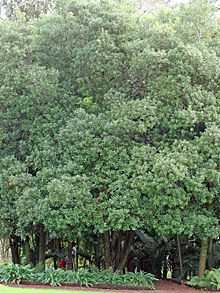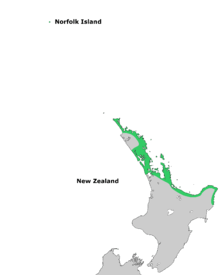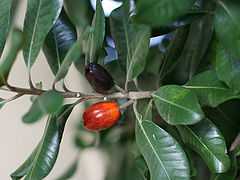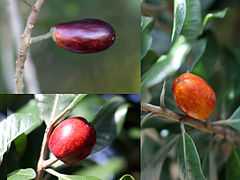Pouteria costata
| Pouteria costata | |
|---|---|
 | |
| Scientific classification | |
| Kingdom: | Plantae |
| (unranked): | Angiosperms |
| (unranked): | Eudicots |
| (unranked): | Asterids |
| Order: | Ericales |
| Family: | Sapotaceae |
| Genus: | Pouteria |
| Species: | P. costata |
| Binomial name | |
| Pouteria costata ( Endl. ) Baehni | |
 | |
| Natural range of Pouteria costata | |
| Synonyms | |
|
Planchonella costata | |
Pouteria costata is a small coastal tree native to the northern North Island (New Zealand) and to Norfolk Island (Australia). In New Zealand, its common name is Tawāpou (from Māori); on Norfolk Island it is called Bastard Ironwood. The name costata is from the Latin costatus (ribbed), a reference to the prominently raised primary nerves of the leaves. Pouteria is a genus of approximately 300 species in the tropics of America, Asia, Australia and the Pacific. A Pouteria species found in other Pacific Islands is sometimes erroneously included in P. costata.
Naming and taxonomy
Tawāpou has undergone several scientific name changes. Some taxonomists consider it to belong in the wastebasket genus Pouteria, others prefer the genus Planchonella (the latter genus is often sunk into the former).[1] Other scientific names of this plant include Pouteria novo-zelandica.[2]
Distribution

Description
P. costata is fairly slow growing, closely branched tree that prefers coastal conditions. It grows up to 20 m tall with a trunk to 1 m in diameter. The bark is rough and varies in colour from grey to brownish-grey. It prefers semi-shade, and is frost tender. The dark green lustrous leaves measure from 5 to 10 cm (sometimes up to 15 cm) long and 2 to 5 cm wide. The main vein in the centre of the leaf is distinct above and below, as are the primary veins on each side of it, which number from 14 to 20. The branchlets and leaf stems are covered with fine flattened hairs. The tiny, delicate flowers, only 4-6 mm in diameter, usually arise from the leaf axils, but also directly from the branchlets. The tree produces large multi-coloured berries 2.5 to 4 cm long which enclose 2 to 4 hard, hard, curved, almost polished seeds, almost as long as the berry, which were used by the Māori to make necklaces. The berries undergo successive stages of colour from green to orange to a very dark red as they ripen, a process that can take from 12 to 15 months. The berries are heavy and will fall from the tree easily if it is disturbed. According to Salmon, a tree with a heavy crop of berries is a spectacular sight (1973:278). When wounded, the tree exudes a sticky, white latex. The white-coloured wood is hard and durable. The fruit are consumed by the kererū, the New Zealand pigeon, and the kākā parrot, both of which were represented on Norfolk Island by closely related birds which are now extinct.[4][5]
Threats

In Māori culture
Tawāpou logs were often used as rollers to help bring large canoes onshore. In Māori traditions of Northland, the canoe 'Waipapa' is said to have landed in Doubtless Bay. The captain asked his crew to take the rollers of the canoe, which had been carried from Hawaiki, and plant them on the slopes of a nearby hill. From the rollers grew a grove of tawāpou (P. costata) trees that today serve as a memorial of the arrival of the canoe. Similar stories are told of groves of tawāpou trees at Houhoura Harbour and Aurere Beach. The Mamaru canoe, whose descendants live around Doubtless Bay and near Kaitaia, carried in its crew an important ancestor named Pou. It is possible that the word 'tawāpou' derives from 'Tawa-a-Pou' 'the Tawa trees of Pou'. A legend from East Cape relates to the Takitimu canoe, which was followed by a flock of Kākā parrots as it left Hawaiki. They gorged on tawāpou berries to sustain them on the long flight. When they reached East Cape they disgorged the seeds, which grew, and eventually the tawāpou trees spread along the coast.[8][9]
Bibliography
- Salmon J T, The Native Trees of New Zealand, AH & AW Reed, Wellington, New Zealand, 1973. ISBN 0-589-01340-8
- "Planchonella costata". Australian Government Species Profile and Threats Database. Retrieved 2010-10-02.
- "Pouteria costata". Flora of Australia Online. Retrieved 2007-07-18.
- "November 2006 newsletter". Bushmansfriend. Retrieved 2010-10-02.
- "Planchonella costata". The Native Plant Centre. Retrieved 2007-07-18.
- "Planchonella costata". New Zealand Plant Conservation Network. Retrieved 2010-10-02.
- "Pouteria costata (Endl.) Baehni". Australian Plant Name Index (APNI). Retrieved 2007-07-20.
- D. J. Campbell, I. A. E. Atkinson (1999). "Effects of kiore (Rattus exulans Peale) on recruitment of indigenous coastal trees on northern offshore islands of New Zealand". Journal of The Royal Society of New Zealand. Vol. 29 No 4, December 1999, pp. 265-290. Retrieved 2010-10-03.
References
- ↑ "Planchonella". Flora of Australia Online. ABRS, Commonwealth of Australia. 1993.
- ↑ "Pouteria queenslandica (P.Royen) Jessup". Australian Plant Name Index (APNI), IBIS database. Centre for Plant Biodiversity Research, Australian Government.
- ↑ Salmon, J (1973). The Native Trees of New Zealand. Wellington: AH & AW Reed. ISBN 0-589-01340-8.
- ↑ Salmon, J (1973). The Native Trees of New Zealand. Wellington: AH & AW Reed. ISBN 0-589-01340-8.
- ↑ D. J. Campbell, I. A. E. Atkinson (1999). "Effects of kiore (Rattus exulans Peale) on recruitment of indigenous coastal trees on northern offshore islands of New Zealand". Journal of The Royal Society of New Zealand. Vol. 29 No 4, December 1999, pp. 265-290. Retrieved {{Subst:CURRENTYEAR}}-{{Subst:CURRENTMONTH}}-{{Subst:CURRENTDAY2}}.
- ↑ Salmon, J (1973). The Native Trees of New Zealand. Wellington: AH & AW Reed. ISBN 0-589-01340-8.
- ↑ D. J. Campbell, I. A. E. Atkinson (1999). "Effects of kiore (Rattus exulans Peale) on recruitment of indigenous coastal trees on northern offshore islands of New Zealand". Journal of The Royal Society of New Zealand. Vol. 29 No 4, December 1999, pp. 265-290. Retrieved {{Subst:CURRENTYEAR}}-{{Subst:CURRENTMONTH}}-{{Subst:CURRENTDAY2}}.
- ↑ "November 2006 newsletter". Bushmansfriend. Retrieved 2010-10-02.
- ↑ Salmon, J (1973). The Native Trees of New Zealand. Wellington: AH & AW Reed. ISBN 0-589-01340-8.
| Wikimedia Commons has media related to Pouteria costata. |